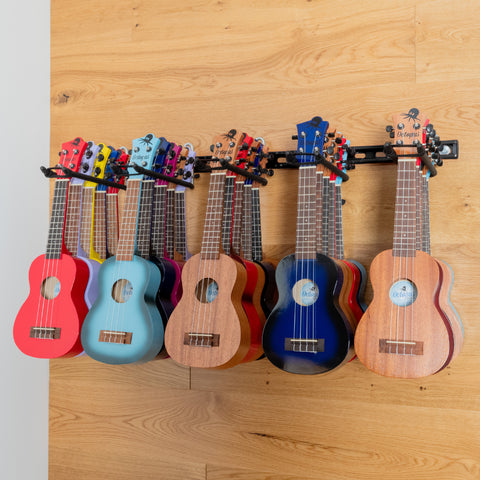Ukuleles are a great instrument to use for whole class work in both primary and secondary schools. They are easy to hold (‘body to body’), easy to get a sound out of and not too expensive for a whole class set.
So you have your ukes - now what?
Make time to tune
When you first get your ukuleles you will need to spend time tuning and tuning and tuning them again as the strings will slip until they have settled. Don’t expect to just be able to unbox them and hand them out; plan for a couple of weeks to get them tuned and ready. You can engage a team of 'tuners' - older students who can help you. Or just tune a few at a time yourself, although this can be very frustrating when one that you have just tuned goes out of tune immediately! It’s worth it though. Once the strings settle, tuning should be no more than a tweak here and there (as long as you train your students not to twist the tuning pegs during lessons).
Sort out your storage
Storing your ukuleles depends on whether you will need to move them or just keep them in one room. Hanging them on hooks on the walls makes for a lovely colourful and musical display, however it can be a pain having to take them down to move them to another room then return them after. One solution is to use a trolley or box with wheels, but make sure that you have somewhere to store this as these can be bulky depending on the model you choose.
Purchase some picks (plectrums)
Giving a child a pick makes them feel like a rockstar. It also avoids the constant moaning about sore fingers from the little ones so is a worthwhile investment. Show the children how to get the picks out of the uke (by holding the ukulele with the hole facing the floor and moving it up and down until the pick falls out) because they seem to mysteriously disappear inside the instruments on a regular basis...
Search for a scheme
The first decision is whether you want the children to play melodies or chords or both. Then you can search out a scheme to follow that includes playing along with songs or backing tracks. That way, even with just one chord, there is a musical focus and as more chords are added, you can divide the class into groups and play one chord per group, or encourage those who can change between chords to do so. There are plenty of free ukulele schemes available on YouTube. Don’t forget to include a tuning song to make the start of your lesson a little easier. Students can strum along and listen for any strange sounds that may mean their instrument is out of tune. Then you can tune it as the rest continue to play along.
Come up with a signal to stop!
You can decide on this with your class. Either flip the ukulele over and rest hands on top for rest position, or hold the uke above their heads when you hold up your hands. There are plenty of ways to do this, but it’s good to encourage this from the start so that when you need to explain something, you have everyone’s attention. It’s also good for large ensemble skills if students learn when to play and when it’s time to listen!







